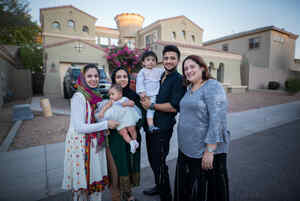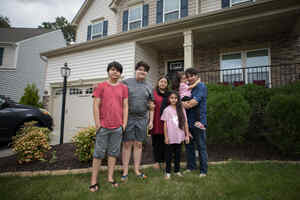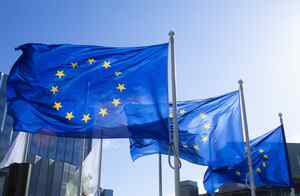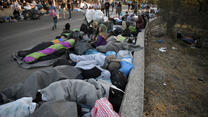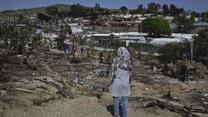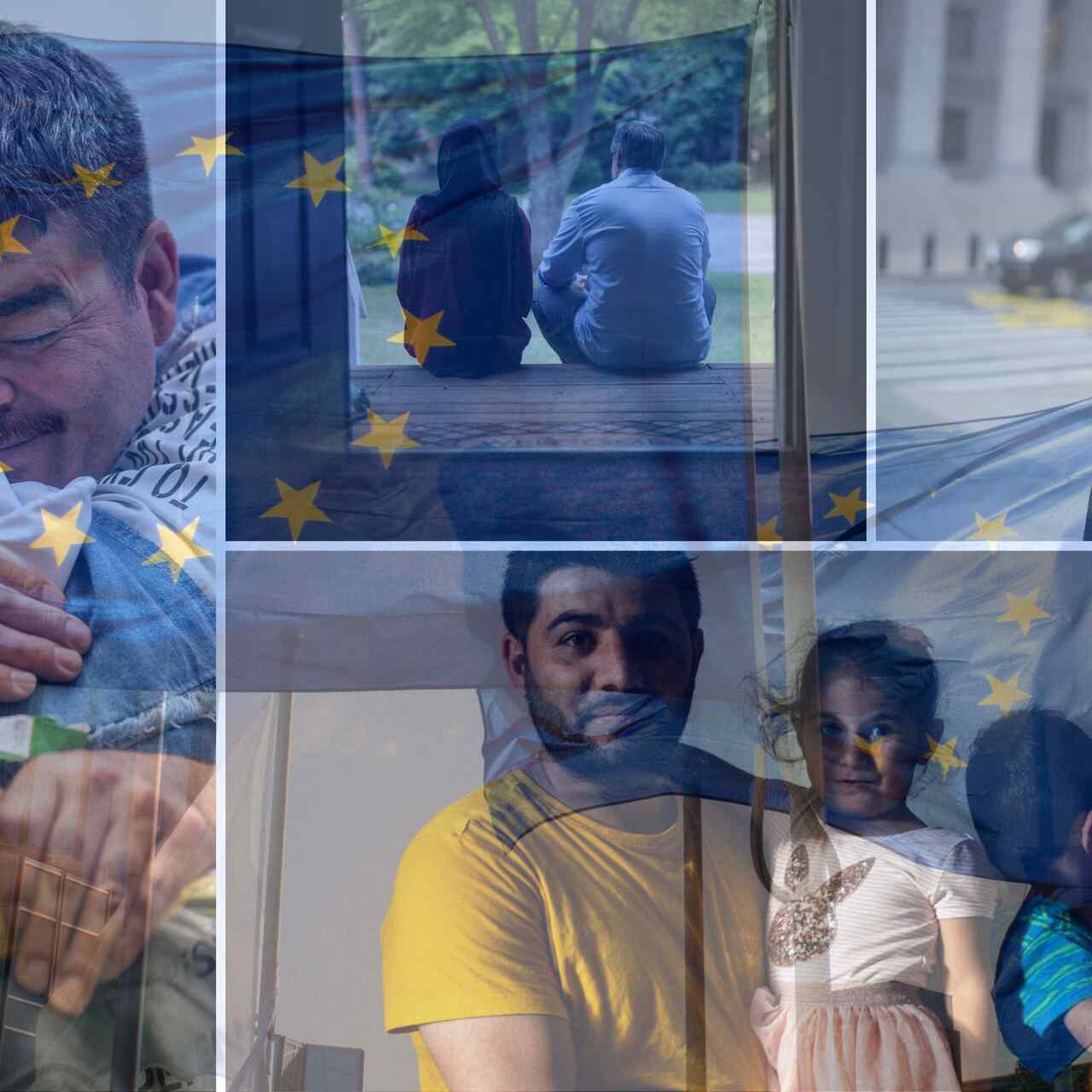
The European Commission has proposed creating so-called 'return hubs', detention facilities located outside of the EU’s borders, designed to hold people whose asylum applications have been refused or who have been deemed unauthorised to remain in the EU for any other reason.
At the moment, people staying irregularly in the EU are usually allowed to remain on its territory until they are deported. However, under this new plan, people would be forcibly removed to ‘return hubs’ in non-EU countries whilst awaiting their final deportation.
EU Home Affairs Commissioner, Magnus Brunner, has described these hubs as one of the EU's "innovative solutions" to address returns.
However, many civil society organisations, including the IRC, have warned that these facilities may well result in people being uprooted from their communities, families being torn apart, people being held in prison-like conditions, and a grave risk of increased human rights violations.
On 8 December, the European Council reached an agreement on the Returns Regulation proposal, including on the provisions on return hubs, confirming the concerns of civil society organisations around vulnerable groups and the lack of safeguards.
The Commission argues that Europe’s migration and asylum systems are under strain and that people who do not have the right to stay in the EU should be removed in a faster, more coordinated way.
The EU’s determination to scale up returns reflects a broader trend in EU migration policy, which has steadily moved towards a focus on deterrence and enforcement policies. Under the new Pact on Asylum and Migration, many safeguards have been weakened, prioritising tighter border control, faster procedures and increased return rates.
In December 2024, the EU Commission President Ursula von der Leyen announced that a stronger legal framework on returns would be one of the first major proposals of her new mandate, promising to “draw lessons from the Italy-Albania protocol” - a controversial and widely criticised deal which enables Italy to transfer people arriving on its territory directly to detention centres in Albania.
In March 2025, the Commission published its full proposal on returns, stating that EU states can “cooperate more flexibly, including through new bilateral agreements or arrangements, and in a more targeted manner to reduce movements of illegally staying third-country nationals”. In short, this allows EU states to take new approaches to enable returns to non-EU countries.
While these proposals are not part of the EU Pact on Asylum and Migration, they can be understood as part of the same logic in their attempts to deter people from seeking protection, making it harder for people to have their asylum claims accepted in Europe, and hollowing out the rights of people whose claims have been rejected.
The IRC and other civil society organisations have been warning authorities that this direction risks diverting attention from Member States’ responsibility in implementing the EU Pact on Asylum and Migration in a way that upholds people’s fundamental rights.
The exact details of how the proposed return hubs would function remain unclear, but here’s what we know so far, in theory:
- The proposal says that EU states could only establish ‘return hubs’ in non-EU countries that respect international human rights standards, including the principle of non-refoulement (the rule that no one should be returned to a country where they could face persecution).
- EU states would need to sign a bilateral agreement with the third country hosting the hubs. In the agreements, EU states would have to define how people would be transferred to the centres, as well as the living conditions and lengths of their stay in the third country.
- Monitoring mechanisms would need to be created to assess the implementation of these agreements and take into account any changing circumstances in the third country.
- Unaccompanied children and families with minors were supposedly excluded from being sent to a ‘return hub’. However, in the agreement that the Council reached in December 2025, families with children would also be sent to ‘return hubs’.
- The Council’s agreed general approach to the Returns Regulation proposal further confirms that ‘return hubs’ can function both as a final destination as well as a centre for ‘onward return towards the final country of return’.
However, many questions remain about how these centres would function in practice. Given the EU’s track record on protecting migrants’ rights in non-EU countries, we are extremely concerned that these conditions will not be respected in reality. For example:
- It is still unclear where these ‘return hubs’ would be based, how people whose asylum claims have been rejected would be transferred to them, and how long they would be forced to stay in these centres.
- Given that these centres will be outside of EU territory, it is unclear how these centres would be monitored, and steps to be taken in case of any potential human rights violations.
- Even if children, and potentially other people with vulnerabilities, are theoretically exempt from being sent to these centres, it is difficult to see how they would be swiftly identified and protected in practice. There is a high risk that both children and people with vulnerabilities will fall through the net.
- Return hubs are being presented as an ‘innovative solution’ to some of Europe’s migration challenges. However, the proposal is legally questionable and risks undermining EU and international law, including the EU Charter of Fundamental Rights.
- Many civil society organisations – including the IRC - fear that these hubs could fail to guarantee adequate protection. They may be used to detain and deport people without sufficient legal safeguards, access to legal advice, or proper assessments of their situation. Without robust safeguards in place, these hubs are likely to result in people being held in de facto prisons, without due process and at grave risk of increased human rights violations.
- The vague wording of the current proposal leaves a lot of questions unanswered. For example, it is not stated that the third-country national will be notified in writing of a decision to send them to a return hub, and the possibility to legally challenge this decision.
- It is not clearly stated which independent body or mechanism will be able to monitor the situation in a ‘return hub’ and what powers it would have to address allegations of human rights violations.
- The current proposal makes it possible for Member States to set up a ‘return hub’ in a third country, through an informal arrangement, which is not legally binding nor necessarily made public or approved by a parliamentary body. This raises critical questions about who would have legal responsibility for any violations. There is also no requirement that the Commission and other Member States are informed and can access the text before an agreement is finalised, limiting opportunities for scrutiny.
- Given the fact that a ‘return hub’ can function as either a final destination or a centre for onward deportation to another country of return, this raises questions of how the risk of non-refoulement will be assessed for onward deportation and what safeguards would be in place.
- Similar externalisation efforts in the past have proved costly, cruel and counterproductive, resulting in thousands of refugees and other migrants being exposed to violence, abuse, exploitation and death. Transferring people to non-EU countries often means removing EU oversight and accountability.
The EU has an obligation to uphold its own laws, standards and principles, rather than trampling over them in pursuit of a dangerous and dehumanising political agenda. Europe should set an example in protecting refugees and upholding dignity, not outsource its responsibilities.
We believe it is perfectly possible for the EU to create an approach to returns which is orderly, sustainable and treats people with dignity and respect.
- The EU and Member States must establish safeguards to ensure that returns are lawful and that there is no risk of refoulement. No one should be sent to a country where they face persecution, torture, or ill-treatment.
- Every asylum application and decision on people’s futures should be assessed on its own merits, taking into account people’s vulnerabilities, family ties, children’s best interests, and the protection of stateless people. -
- Returns do not need to be cruel or chaotic. In the IRC’s experience, returns that returns that are done in a veritably voluntary and dignified manner are more sustainable. For example, the IRC’s ‘Safe Return’ programme, in collaboration with the Honduran Red Cross and Plan International Honduras, demonstrated how improving municipal and civil society services, economic opportunities, and reliable information can help achieve sustainable returns and boost reintegration.
- The EU needs to shift its focus from keeping people away from its territory at all costs to investing in welcome, reception and integration - housing people behind barbed wire in closed facilities exacerbates their trauma and suffering, and prevents them from contributing positively to their host communities.
Migration is a fact of life. If the EU hopes to create a truly effective, orderly migration policy this must be centred on managing movement safely, humanely, lawfully, and with respect for human dignity.
Learn more about the Pact on Migration and Asylum here.
Related content:
IRC news and articles related to refugee resettlement in the EU.
Understand the different tools designed to support people seeking protection in Europe including resettlement, complementary pathways, and family reunification.
More on the IRC's work in Europe shaping policies to help people affected by humanitarian crises to survive, recover and rebuild their lives.
